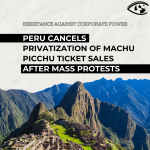US: Toxic sites' cleanup at risk
Mexican purchaser of Asarco accused of crafty plan to shed its liability.
It is one of Mexico's most low-profile companies, run by a politically connected family that is no stranger to the bare-knuckles world of international mining.
Now, Grupo Mexico S.A. de C.V. could find itself at the center of the bankruptcy reorganization of Asarco, a century-old American mining and smelting company whose liabilities include the environmental cleanup of 94 Superfund sites in 21 states. The two California sites are in Redding and the East Bay city of Rodeo.
The stakes are high. The bill to clean up Asarco's environmental contamination could total more than $1 billion, according to court filings. Depending on what happens in the bankruptcy reorganization, U.S. taxpayers ultimately could be responsible for the tab.
In addition, more than 85,000 asbestos exposure-related claims worth an estimated $500 million have been filed against Asarco, and more are expected.
Over the coming months, lawyers have said in court documents, they will try to convince a federal bankruptcy judge in Texas that Grupo Mexico "systematically cannibalized" Asarco since buying it six years ago and should be ordered to help cover its debts.
"They stole the piggy bank," said John Tate, a San Antonio lawyer representing asbestos claimants in the reorganization. "Absolutely we will go after them. They are the deep pockets."
Asarco lawyers dismiss the claims as "innuendo and speculation."
The Asarco saga, however, is about more than just the financial collapse of a once-profitable company following its unexpected takeover. It is also about more than corporate maneuvering to gain control of some of the world's most valuable copper mines high in the Andes of Peru.
The Asarco bankruptcy reorganization has exposed weaknesses in one of the nation's premier environmental programs: the Superfund.
The fund was created in 1980 to clean up the nation's legacy of toxic pollution. It was financed with a special corporate tax that expired in 1995.
The Superfund's $3.8 billion surplus has been spent, and the program now lives off annual appropriations from Congress. Unless Congress approves another funding mechanism, taxpayers will increasingly pay for the environmental cleanups.
Asarco's reorganization will only add to the burden.
Grupo Mexico's takeover of Asarco in 1999 set off warning bells in the EPA and the Justice Department.
Asarco was considered an attractive takeover target because of its 54 percent interest in the Southern Peru Copper Co. The Peruvian company owns two mines in South America's rich copper belt and in 1999 had announced the discovery of major new reserves.
Federal regulators were concerned about Asarco's mounting environmental liabilities and a balance sheet that was steadily tipping toward insolvency. But they were powerless to stop the takeover.
Founded in the 1950s by Jorge Larrea Ortega, Grupo Mexico is the third-largest copper producer in the world, controls Mexico's largest and most profitable railroad and reportedly is interested in buying Aeromexico, one of Mexico's major airlines.
Larrea died in 1999 at age 87, and the company now is run by his son, German Larrea Mota-Velasco. As major players in the international mining market, the family is considered sophisticated and shrewd. But it is a cutthroat industry.
In filings in the Texas bankruptcy court and in a New York case, lawyers for the asbestos claimants allege that Grupo Mexico's "bust-up" acquisition of Asarco was aimed squarely at acquiring control of the Peruvian mines.
Within days of the takeover in November 1999, Grupo Mexico named some of its corporate officers, including Larrea, to top positions at Asarco. Grupo moved Asarco's corporate offices from New York to Phoenix, where it shared office space with another Grupo mining subsidiary, Americas Mining Corp.
Less than a month later, Asarco began selling its non-mining assets to pay for its own takeover, the asbestos lawyers claim. Asarco sold its specialty chemicals division, Enthone, for $503 million and its aggregates division, American Limestone, for $211 million. The proceeds from both sales were used to pay for Grupo Mexico's buyout of Asarco.
The asbestos lawyers allege the "fire sales" of Enthone and American Limestone exacerbated Asarco's financial problems and served as a prelude to Grupo Mexico's plan to acquire control of Asarco's "crown jewel": the Southern Peruvian Copper Co.
Takeovers often are financed by selling a company's assets. But such a move could be illegal, under certain circumstances. According to court filings in the reorganization case and in another case filed by asbestos lawyers against Asarco in New York, Grupo Mexico engaged in the "fraudulent conveyance" of Asarco assets to finance its takeover and to limit future Asarco financial liabilities. Such allegations can be difficult to prove.
"It was a classic leveraged buyout carried out by the fraudulent conveyance of Asarco's assets, and they got SPCC almost for free," said Alan Rich, a Dallas lawyer representing asbestos claimants.
Grupo Mexico initially sought to purchase the Peruvian mines for $640 million in the summer of 2002, a price tag asbestos lawyers insist was outrageously low. EPA and Justice Department lawyers, in a step believed unprecedented, secured a temporary restraining order in federal court to block the sale.
EPA grew increasingly anxious about whether Asarco would be able to fulfill its written assurances to clean up its Superfund sites after the company sold its chemicals and aggregate divisions.
Asarco had approached EPA about a "global settlement" covering its environmental liabilities. With the temporary restraining order in place, government and Asarco lawyers intensified settlement negotiations.
In early 2003 they reached an agreement allowing Grupo Mexico to take control of the Peruvian mines for $765 million, $125 million more than the original purchase price. Grupo Mexico also agreed to fund a $100 million trust dedicated to cleanups at Asarco's mining and smelting sites. EPA and the Justice Department agreed not to pursue any enforcement actions against Asarco for three years.
"EPA and the Justice Department took a pittance to roll over and go away," said Tate, the San Antonio asbestos claims lawyer.
In agreeing to the settlement, EPA officials said the $100 million trust was better than nothing, considering Asarco was in financial turmoil.
"The United States believed at the time and continues to believe that the settlement was in the best interest of maximizing environmental cleanups," said Cynthia Magnuson, a Justice Department spokeswoman.
The environmental trust fund could become part of the reorganization proceedings.
- 186 Financial Services, Insurance and Banking
- 190 Natural Resources



